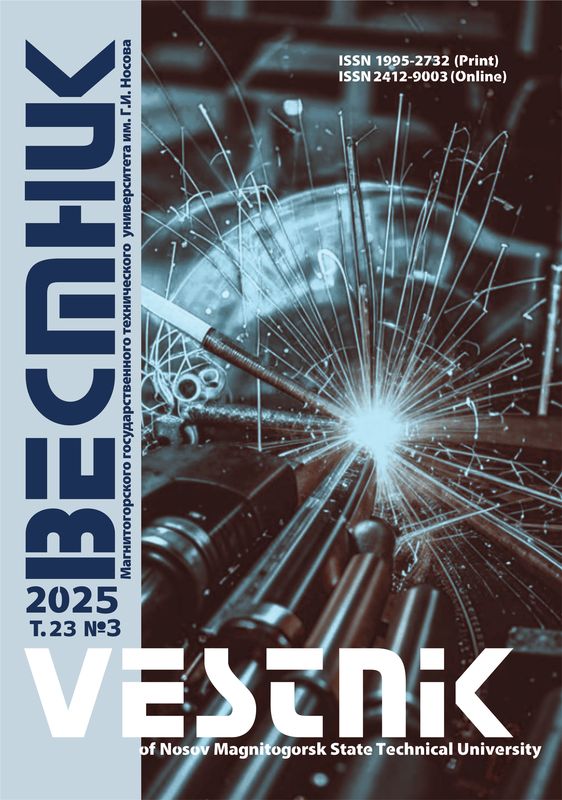Abstract
Relevance: This article examines an important scientific and practical problem of the surface structure in thin cold-drawn steel wire influenced by changing strain patterns during the actual drawing operation. Objectives: This research aims to look at how the microstructure is formed in the surface layers of thin wires and to identify the patterns, as well as to determine if this process can be controlled across the section of the wire to ensure the best combination of properties. Methods Applied: The material of the research was thin brass wire made from steel grade 80 of the following diameters (in mm): 1.75, 1.73, 1.574, 1.325, 1.113 and 0.933. The equipment of the research included a scanning electron microscope (SEM) by JEOL (with zoom rates of 2000, 5000 and 20000x) and the microhardness tester DUH - 211S by SHIMADZU. Findings: The authors of the study detected a near-surface zone with a turbulent structure caused by the shear stresses present in the zone, which, alongside the major shear strain, can induce an additional torsional deformation. The approximate depth and radius of the abnomal layer were determined. The authors show that a greater deformation leads to greater hardening of and more turbulence in the surface layer. This can be confirmed by the microhardness change dynamics versus the degree of deformation registered in a drawing operation. Thus, at small degrees of deformation the distribution of microhardness radially from the surface tends to be random. However, as the deformation becomes more intense, a clear trend is observed of the maximum microhardness being at the surface around the areas with abnormal turbulized structure. It can be explained by the fact that in thin wire drawing the rate of deformation tends to be higher at the surface than in the core. A higher degree of deformation is found to be accompanied with more intense hardening rates. The knowledge gained can be used to determine the ultimate drawability of wire rod and wire while identifying the structure and the quality of thin wires.
Keywords
Cold working, thin wire, shear strain, turbulized surface layer, strength, microhardness, SEM.
1. Ulewicz R., Mazur M., Bokuvka O. Structure and mechanical properties of fine-grained steels. Transportation Engineering. 2013, no. 41/2, рр. 111–115.
2. Schwinn V., Bauer J., Fluess P. Recent developments and applications of TMCP steel plates. Revue de Metallurgie, 2011, no. 5, рр. 283−294.
3. Junru Li, Chaolei Zhang, Bo Jiang, Leyu Zhou, Yazheng Liu. Effect of large-size M23C6-type carbides on the low-temperature toughness of martensitic heat-resistant steels. Journal of Alloys and Compounds, 2016, vol. 685, pp. 248–257.
4. Seok Su Sohn, Seokmin Hong, Junghoon Lee, Byeong-Chan Suh, Sung-Kyu Kim, Byeong-Joo Lee, Nack J. Kim, Sunghak Lee. Effects of Mn and Al contents on cryogenic-temperature tensile and Charpy impact properties in four austenitic high-Mn steels. Acta Materialia, 2015, vol. 100, pp. 39–52.
5. Huang Wang, Guo He. Effects of Nb/Cr on the cryogenic impact toughness of the deposited metal of ENiCrFe-9. Mate-rials Science and Engineering: A, 2016, vol. 672. pp. 15–22.
6. Lu Y.Q., Hui H. Investigation on Mechanical Behaviors of Cold Stretched and Cryogenic Stretched Austenitic Stainless Steel Pressure Vessels. Procedia Engineering, 2015, vol. 130. pp. 628–637.
7. Kablov E.N., Lebedev M.P., Startsev O.V., Golikov N.I. Cli-matic testing of materials, structural elements, equipment and machinery in extremely low temperatures. Trudy VI Evraziyskiy simpozium po problemam prochnosti materialov i mashin dlya regionov kholodnogo klimata Eurastrencold-2013 [Proceedings of the VI Eurasian Symposium on the Strength of Materials and Machines Designed for Cold Climates Eur-astrencold-2013], Yakutsk, 2013, pp. 5–7. (In Russ.).
8. Chukin M.V., Poletskov P.P., Nabatchikov D.G., Gushchina M.S., Berezhnaya G.A. The effect of alloying elements on steel properties at different cooling rates. Kachestvo v obrabotke materialov [Quality of materials processing], 2016, no. 1(5), pp. 5–8. (In Russ.).
9. Chukin M.V., Poletskov P.P., Nabatchikov D.G., Gushchina M.S., Berezhnaya G.A., Alekseev D.Yu., Khakimullin K. Mathematical dependences between the mechanical properties of high-strength rolled sheet steel and its chemical composition and heat treatment conditions. Vestnik Magnitogorskogo gosudarstvennogo tekhnicheskogo universiteta im. G.I. Nosova [Vestnik of Nosov Magnitogorsk State Technical University], 2016, no. 4, pp. 72–75. (In Russ.).
10. Chukin M.V., Poletskov P.P., Nabatchikov D.G., Gushchina M.S., Berezhnaya G.A. Study of the effect of the tempering temperature on mechanical properties of high-strength sheet metal. Trudy XVII Mezhdunarodnaya nauchnaya konferentsiya "Novye tekhnologii i dostizheniya v metallurgii i inzhenerii materialov i protsessov": materialy konferentsii pod red. Yaroslava Borytsa [XVII International Scientific Conference “New Technologies and Developments in Metallurgy and Material and Production Engineering”, Proceedings of the conference edited by Jarosław Boryca, Rafal Wyczolkowski], Czestochowa, 2016, pp. 227–231.












